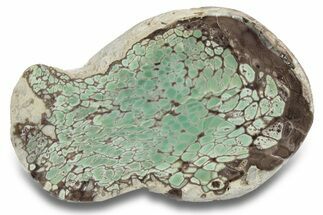This Specimen has been sold.
2.75" Wide, Polychrome Jasper Heart - Madagascar
This is a beautiful, 2.75" wide hand polished piece of polychrome (picture) jasper found in the deserts of Madagascar. The specimen has been sculpted and polished into the shape of a heart.
About Polychrome Jasper
Polychrome jasper (also known as desert jasper) is known as one of the rarest forms of jasper: it is only mined from a single location in Madagascar! The jasper deposits are typically in ribbon-like formations, and are almost always multicolored. The colors presented by this mineral are commonly earthy purples, tans, reds, and pinks, but teal polychrome jasper is one of the more sought after and desired colors. Some people consider it a form of picture jasper.
Polychrome jasper (also known as desert jasper) is known as one of the rarest forms of jasper: it is only mined from a single location in Madagascar! The jasper deposits are typically in ribbon-like formations, and are almost always multicolored. The colors presented by this mineral are commonly earthy purples, tans, reds, and pinks, but teal polychrome jasper is one of the more sought after and desired colors. Some people consider it a form of picture jasper.
About Jasper
Jasper is a term that can be applied to an opaque variety of chalcedony. The opaqueness is due to a higher concentration of impurities mixed with silica/quartz compared to other varieties of silica, such as quartz or agates. Like agate it may form in a wide variety of colors, and is often multi-colored. In most cases, jasper forms when silica-rich fluids permeate throughout a soft sediment or volcanic debris deposit. The fluids then crystallize around the particles/impurities, resulting in a cementation process. Most often, the impurities present determine the coloration of the deposit following solidification, but other factors can play a role in the color of what is now considered a jasper.
Jasper is a term that can be applied to an opaque variety of chalcedony. The opaqueness is due to a higher concentration of impurities mixed with silica/quartz compared to other varieties of silica, such as quartz or agates. Like agate it may form in a wide variety of colors, and is often multi-colored. In most cases, jasper forms when silica-rich fluids permeate throughout a soft sediment or volcanic debris deposit. The fluids then crystallize around the particles/impurities, resulting in a cementation process. Most often, the impurities present determine the coloration of the deposit following solidification, but other factors can play a role in the color of what is now considered a jasper.
SPECIES
Polychrome Jasper
LOCATION
Madagascar
SIZE
2.75" wide
CATEGORY
SUB CATEGORY
ITEM
#205234
 Reviews
Reviews













